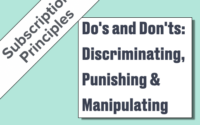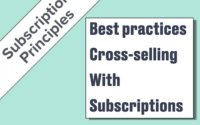What is a Subscription model? What is its interest?
Disclaimer: In this article, we do not consider insurances, long-term rentals or time-shares as subscriptions because they are subject to specific regulations.
Summary
A subscription is a contract for the acquisition of a regular service for an indefinite period in exchange for regular payments.
Anything that wears out, is consumed, becomes obsolete or requires access management can be sold as a subscription.
The advantages of a subscription model are: the creation of regular income, a predictable business, the reduction of acquisition costs and customer loyalty.
1. What can I sell as a subscription?
I can sell as a subscription anything that wears out, is consumed, becomes obsolete or requires access management.
Here are some examples:
What is consumed or what wears out: the consumable.
- printer ink,
- baby diapers,
- dog food,
- clothes,
- cosmetics.
What requires access management for a service or a good:
- transportation,
- Internet, mobile phone,
- amusement parks,
- software
What becomes obsolete quickly (and therefore requires new versions constantly):
- newspaper,
- security software
2. Why must the duration be indefinite and the payments recurring?
A subscription is a contract to acquire a regular service for an indefinite period in exchange for regular payments.
a. For there to be a subscription, the duration must be indefinite.
A subscription occurs when a service is provided, without interruption, as long as the payments are honored. For example, I have access to a streaming music service as long as I don’t cancel it.
When one of the parties (merchant or subscriber) decides to terminate ❌ the subscription, it’s canceled. The service continues to be provided up to the amount paid.
⚠️ On the other hand, if the duration of the contract is fixed and the service is paid in advance, then it’s a prepaid service. For example, I pay $60 for 12 issues of a monthly newspaper. I have prepaid for 12 newspapers and their delivery. I am not a subscriber because without action on my part, the service will cease.
b. For there to be a subscription, the payments must be recurring.
Weekly, monthly or yearly payments, frequency doesn’t matter. But regularity matters. The customer makes an initial payment, then the merchant creates the recurrence.
Regulatory authorities usually call this “automatic renewal subscription”. A renewal is “automatic” when it’s initiated by the merchant. In contrast, a renewal is “manual” when it’s initiated by the customer.
If the customer unsubscribes, the service ceases and payments stop.
If the merchant fails to get paid, the customer is unsubscribed, the service ceases.
c. Beware of subtleties:
- a free subscription ❌ is not a subscription,
- a subscription with a free trial only becomes a subscription after a first payment is made ✅
- an access to a service for a limited period is not a subscription ❌. For example, 6-month access to a video streaming service is not a subscription.
3. What is the interest of a subscription?
a. A Regular Income.
Let’s take the example of the software industry: A publisher sells its software under a perpetual license, it releases a new version every 3 years. With each new version, sales increase to reach a peak of adoption. Then they stagnate. Finally, they go down when consumers are aware of the imminent release of the next version.
Sales are not linear and there is a gap between investment and return on investment.
b. A Predictive Business
For a mature subscription business (which is no longer in the launch phase), booking is very predictive; it’s calculated with the 3 macro KPIs:
– Opportunity (Exp): the number of subscriptions expiring over the period. This figure is known since it’s the current number of subscriptions.
– Retention Rate (RR%): percentage of renewed subscriptions over total number of subscriptions. This figure is known for the past and present; to predict the future, we just use the current value adjusted according to trend.
– Average Selling Price (ASP): ratio between booking and the number of sold units. This figure is known for the past and present; to predict the future, we just use the current value adjusted according to trend.
Booking = Exp. x RR% x ASP
c. More Loyal Customers
The initial purchase decision always belongs to the customer but renewals are initiated by the merchant. Thus, the transaction is more likely to be successful when it doesn’t require any action from customer.
Let’s imagine that we have to pay our mobile subscription online each month with a 48-hour payment window. There is a good chance that we’ll miss a payment and experience a service interruption.
d. Reduced Acquisition Costs
To acquire new subscribers, I make investment choices that seem relevant to me according to the different phases my customers are in: Awareness, Interest, Consideration, Intent, Evaluation, and Purchase.
When it’s time to renew, my subscribers already went through these phases, they already own and use the product. I “just” have to convince him not to unsubscribe.
Of course, there are costs associated with these retention activities but:
The costs are lower: I no longer have performance-related costs (i.e.: affiliate commission)
Simpler communication: all customers are in the same phase,
More targeted actions: I focus on customers showing signs of leaving.
4. What does the subscription model involve?
Subscription is a model based on retention, based on the long term:
- The more mature a subscription business is, the larger the installed base and the lower growth (see my previous article on this subject). You should not expect strong growth but rather an income.
- Optimizing your retention rate, your product offering, your pricing, your communication, your acquisition channels requires time. There is no point in launching a subscription model if you are not sure you want to maintain your offer for several years.
👉 Key points to remember
- A subscription implies recurring payments initiated by the merchant in exchange for the permanence of a service until one of the parties terminates it.
- Almost everything can be sold as a subscription.
- A subscription business is regular, predictive with controlled costs: it’s more of an income business than a growth business.



